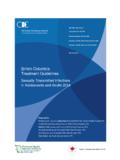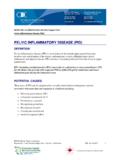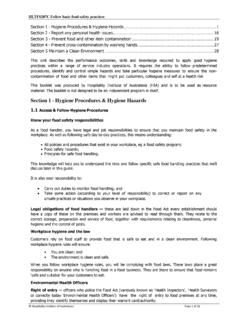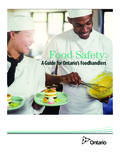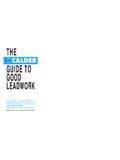Transcription of ENVIRONMENTAL HYGIENE MONITORING A GUIDE FOR …
1 ENVIRONMENTAL HYGIENE MONITORING A GUIDE FOR ENVIRONMENTAL HEALTH OFFICERS For more information about the program contact: Food Protection Services BC Centre for Disease Control Provincial Health Services Authority 655 West 12th Ave Vancouver, BC V5Z 4R4 Ph: e-mail : Table of Contents Rationale for the use of ENVIRONMENTAL Sampling Products .. 3 1. Educational Tool for Process 3 2. Educational Tool for General HYGIENE .. 3 3. Tool for Investigation of Outbreaks.
2 3 4. Prepare for Situations known and 3 Successful ENVIRONMENTAL HYGIENE Sampling Inspector Notes .. 4 A. Use and Interpretation of Swabs / Sponges as Indicators of ENVIRONMENTAL 5 Key points: .. 5 Field Use .. 5 B. Use and Interpretation of Contact Agar Slides and Protein or ATP Detection Swabs as Indicators of ENVIRONMENTAL HYGIENE .. 7 Key points: .. 7 Field Use .. 7 C. Use and Interpretation of Swabs / Sponges for Pathogen MONITORING .. 9 Key points: .. 9 Field Use .. 9 Interpretation of ENVIRONMENTAL HYGIENE Sampling Results.
3 11 What does the test result mean? .. 11 How can I explain the test result to the operator? .. 11 Log Value 11 Standard Interpretation Table .. 13 Interpretation of HYGIENE Test Results (Operator Worksheet) .. 14 ENVIRONMENTAL Sampling Products .. 15 References .. 16 October 5, 2010 Version 3 2 Rationale for the use of ENVIRONMENTAL Sampling Products ENVIRONMENTAL sampling products can be used to provide evidence for process control in food premises, as an educational tool for general HYGIENE in food and other premises, as a tool to investigate suspected foodborne or gastrointestinal outbreak and to prepare for unknown situations.
4 1. Educational Tool for Process Control The ENVIRONMENTAL sampling products can be used real time on-site to demonstrate whether a surface is cleaned and disinfected. In large industry settings these tools are often used to verify whether a cleaning process successfully removed all materials. This concept is very important, because areas where soil deposits collect can serve as a nutrient site for bacteria. Soil doesn t mean only dirt when talking about sanitation practices, it also include protein deposits and any organic / inorganic matter that can be utilized by bacteria.
5 When bacteria multiply they can form biofilms, these layers of bacteria can change the surface pH, cause odour and taste problems in food, and most importantly provide a site where pathogenic bacteria may enter into the food supply. In the factory or restaurant setting, periodic cleaning of surfaces, especially those in contact with food, is necessary. One method of checking and verifying that the procedure and process used by the operator to clean and sanitize surfaces is working is by using ENVIRONMENTAL sampling products such as sponges and swabs.
6 If bacteria is still present, or if protein residue is detected translates to poor sanitation methods. This creates an opportunity to look at the process at each step and to determine where improvements are needed. If desired, quantitative measurements (number of bacteria per cm2 ) can be taken by the EHO and sent to the laboratory for analysis. 2. Educational Tool for General HYGIENE The ENVIRONMENTAL sampling products can be used as a method to show the importance of general HYGIENE . Areas of concern include, for example, handwashing, handwashing stations, buttons, doorknobs, and contact areas in institutional or community care facilities where germs or pathogens may spread between guests and residents.
7 A determination of the quantity of bacteria, while possible, is not as important as the concept that bacteria are present. This approach is not meant to foster fear, but rather to reinforce the importance of cleaning common areas. Many people are shocked to discover exactly where bacteria can be found. 3. Tool for Investigation of Outbreaks ENVIRONMENTAL sampling products are useful when trying to determine the reservoirs of pathogens in any facility implicated in an outbreak. They can be viewed as another tool in the tool-kit when trying to trace down the source or secondary points of contact caused by cross-contamination.
8 Sponge and swab samples can be sent to the laboratory for specific pathogen testing (Salmonella, Campylobacter, etc.) and if successful, biotyping of isolates and comparison to human illnesses can be ascertained. When investigating outbreaks, leftover implicated food is often not available. It may be possible to look for traces of contamination in settings where outbreaks occur. For example, if cross-contamination between raw eggs and food is implicated, both eggs, finished foods and sponge/swabs of the mixer, sink and counter can be sent before the operator cleans up.
9 Establishing a link between the premise (as the source) can be confirmed more easily with solid lab results, and can help rule in and rule out suspected epidemiological links. 4. Prepare for Situations known and unknown ENVIRONMENTAL sampling products are available. Learning how to use them now, both as an educational tool, and tool for investigation of outbreaks, will prepare EHO s. These tools may aid in possible future October 5, 2010 Version 3 3situations, when outbreaks being investigated involve unknown pathogens, and unknown transmission vectors.
10 Successful ENVIRONMENTAL HYGIENE Sampling Inspector Notes 1. Review the file copy of the sanitation plan for the facility that you plan to sample. 2. Based on your recent experience with the operator(s) decide before you visit the facility on the equipment or surfaces that you want to sample. Where and what you sample might change when you arrive at the facility, but planning ahead will help you to identify (and remember) the problem areas from previous inspections. 3. Consider your reason for testing one educational method is to use a contact slide and leave in place at the facility; or you may wish to demonstrate HYGIENE problems and want a quantitative result (sample must be sent to the laboratory for a report to be issued).



